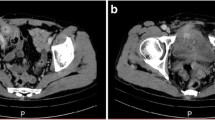Summary
A young and otherwise healthy man was admitted to a district hospital, for treatment of adhesional disease developed as a result of complicated appendectomy two decades before. He was treated by laparoscopy, during which seven small-bowel loops were released from the abdominal wall. Nine days later, laparotomy became necessary because of recurrent intestinal obstruction. This laparotomy revealed two small bowel leakages in the right lower abdomen with purulent peritonitis. Resection of the leaking small bowel loops was performed. When the patient was transferred to our department, he was in a serious condition with persistent fever and a few days later multiple entero-cutaneous fistulae appeared in the wound, causing a large abdominal wall defect of 31 × 16 cm. Following 8 weeks of fistula-shrinking, the size of the defect was reduced to 17 × 9 cm. After resection of intestinal loops including multiple fistulae, a large abdominal wall-defect persisted. Hernia repair was performed 8 months after resection by intraperitoneal implantation of a large 30 × 40 cm ePTFE prosthetic patch (Gore-Tex®), fixed by transfascial subcutaneous sutures. Follow-up at 20 months revealed restoration of abdominal wall integrity and good general health.
Similar content being viewed by others
References
Bailey IS, Rhodes M, O'Rourke N, Nathanson L, Fielding G (1998) Laparoscopic management of acute small bowel obstruction. Br J Surg 85: 84–87
Bleichrodt RP, Simmermacher RK, van der Lei B, Schakenraad JM (1993) Expanded polyte-trafluoroethylene patch versus polypropylene mesh for the repair of contaminated defects of the abdominal wall. Surg Gynecol Obstet 176: 18–24
Brandt CP, McHenry CR, Jacobs DG, Piotrowski JJ, Priebe PP (1995) Polypropylene mesh closure after emergency laparotomy: morbidity and outcome. Surgery 118: 736–740; discussion 740–731
Brown GL, Richardson JD, Malangoni MA, Tobin GR, Ackerman D, Polk HC, Jr. (1985) Comparison of prosthetic materials for abdominal wall reconstruction in the presence of contamination and infection. Ann Surg 201: 705–711
Dayton MT, Buchele BA, Shirazi SS, Hunt LB (1986) Use of an absorbable mesh to repair contaminated abdominal-wall defects. Arch Surg 121: 954–960
Federmann G, Walenzyk J, Schneider A, Bauermeister G, Scheele C (1995) Laparoscopic therapy of mechanical or adhesion ileus of the small intestine-preliminary results. Zentralbl Chir 120: 377–381
François Y, Mouret P, Tomaoglu K, Vignal J (1994) Postoperative adhesive peritoneal disease. Laparoscopic treatment. Surg Endosc 8: 781–783
Gillion JF, Begin GF, Marecos C, Fourtanier G (1997) Expanded polytetrafluoroethylene patches used in the intraperitoneal or extra-peritoneal position for repair of incisional hernias of the anterolateral abdominal wall. Am J Surg 174: 16–19
Ibrahim IM, Wolodiger F, Sussman B, Kahn M, Silvestri F, Sabar A (1996) Laparoscopic management of acute small-bowel obstruction. Surg Endosc 10: 1012–1014; discussion 1014–1015
Leber GE, Garb JL, Alexander AI, Reed WP (1998) Long-term complications associated with prosthetic repair of incisional hernias. Arch Surg 133: 378–382
Okunski WJ, Sonntag BV, Murphy RX, Jr. (1996) Staged reconstruction of abdominal wall defects after intra-abdominal catastrophes. Ann Plast Surg 36: 475–478
Paul A, Korenkov M, Peters S, Fischer S, Holthausen U, Kohler L, Eypasch E (1997) Mayo duplication in treatment of incisional hernia of the abdominal wall after conventional laparotomy. Results of a retrospective analysis and comparison with the literature. Zentralbl Chir 122: 862–870
Stoppa RE (1989) The treatment of complicated groin and incisional hernias. World J Surg 13: 545–554
Taylor SG, O'Dwyer PJ (1999) Chronic groin sepsis following tension-free inguinal hernioplasty. Br J Surg 86: 562–565
Trupka AW, Hallfeldt KK, Schmidbauer S, Schweiberer L (1998) Management of complicated incisional hernias with underlay-technique implanted polypropylene mesh. An effective technique in French hernia surgery. Chirurg 69: 766–772
Vix J, Meyer C, Rohr S, Ch. B (1997) The treatment of incisional and abdominal hernia with a prosthesis in potentially infected tissues — A series of 47 cases. Hernia 1: 157–161
Wantz GE. (1991). Atlas of Hernia Surgery. Raven Press: New York.
Author information
Authors and Affiliations
Rights and permissions
About this article
Cite this article
Petersen, S., Tempel, S., Freitag, M. et al. Large hernia caused by entero-cutaneous fistula after laparoscopic adhesiolysis: Report of a case. Hernia 4, 33–36 (2000). https://doi.org/10.1007/BF01230590
Received:
Accepted:
Issue Date:
DOI: https://doi.org/10.1007/BF01230590




